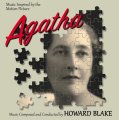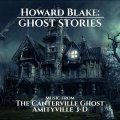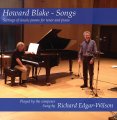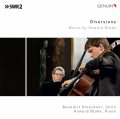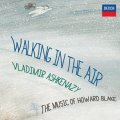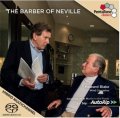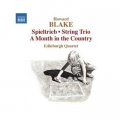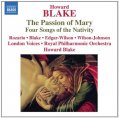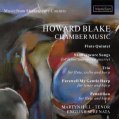 Highbridge Music Ltd.
Highbridge Music Ltd.
Studio 6, 18 Kensington Court Place, London W8 5BJ, UK
Email: howard@howardblake.com
*HOWARD BLAKE SONGBOOK op.684 (December 2016)
An album of concert songs for tenor and piano
Published by: highbridge musicCommissioned by: Richard Edgar Wilson
Instrumentation: tenor (high voice) and piano
[Key to Abbreviations]
Note on Lyrics: Settings of classic poems by Hardy, Osbert Sitwell, Shakespeare, Browning, Joyce and Keats
Duration: 71 mins
First Performance: Recorded by Richard Edgar-Wilson tenor and Howard Blake piano at Snape Aldeburgh August 1-3 2016
Sheet Music Available
Instrumental / piano score for saleThis is a 74-page spiral-bound printed album of the songs on the CD, specially arranged for performance with easy page-turning.(They are also available individually under song title)
Recordings Available
CD album available from December 18th 2016 from Highbridge Music, contact anna@annamenzies.com
Movements
-
1:
Earth and Air and Rain
1 minutes
55 seconds
Poem by Thomas Hardy
-
2:
Winter the Huntsman
1 minutes
32 seconds
Poem by Osbert Sitwell
-
3:
Shakespeare Songs
21 minutes
12 seconds
Nine songs, for titles see the song-cycle 'Shakespeare Songs' opus 378
-
4:
A Toccata of Galuppi's
10 minutes
00 seconds
Poem by Robert Browning
-
5:
James Joyce Songs
24 minutes
09 seconds
15 poems by James Joyce from his collection 'Chamber Music', for titles see the song-cycle 'James Joyce Songs' opus 641
-
6:
La Belle Dame sans Merci (Winterdream)
7 minutes
26 seconds
Poem by John Keats
-
7:
T Sleep
3 minutes
49 seconds
Poem by John Keats
Notes
THE SONGS:EARTH AND AIR AND RAIN opus 1E 1957, poem by Thomas Hardy
In spring 1957 I was astonished to win a piano scholarship to the Royal Academy of Music. I requested absence from Brighton Grammar School to prepare for this and devote myself solely to music, completing this, my first ‘art-song’ shortly afterwards.
WINTER THE HUNTSMAN opus 4 1958, poem by Osbert Sitwell.
At the start of my second term at the Royal Academy composition professor Howard Ferguson suggested I create a set of variations on a theme of Bartok. I composed a set of passionately-conceived movements for piano in a style that was more contemporary-sounding than anything previous. Ferguson was full of admiration and I was encouraged to write this cogent and somewhat unsettling song.
SHAKESPEARE SONGS (a song-cycle) opus 605 1987, poems by William Shakespeare. The songs from ‘As you like it’ were first composed for Adrian Noble’s Royal Shakespeare Company production of the play at Stratford-upon-Avon in 1985. The songs from the other plays resulted from a commission for a song-cycle by Chester Festival for the Medici String Quartet and tenor Martyn Hill in 1987. They are here arranged for tenor and piano.
Under the greenwood tree [The Country} from ‘As you like it.’
Blow,blow thou winter wind [The Wind] from ‘As you like it.’
Full fathom five [The Sea] from ‘The Tempest’.
It was a lover and his lass [ Spring] from ‘As you like it.’
When icicles hang by the wall [Winter] from ‘Love’s Labours Lost.’
Hymn to Hymen [Wedding Hymn] from ‘As you like it.’
Come away death [Lament] from ‘Twelfth Night’.
When that I was and a little tiny boy [Clown’s Song] from ‘Twelfth Night’.
Fear no more the heat o' the sun [Dirge for Fidele] from ‘Cymbeline’.
A TOCCATA OF GALUPPI’S opus 263, 1978 (Robert Browning) 10’.00’’
This large-scale song or scena was originally commissioned by The Arts Council for harpsichord and baritone and performed by Michael Leighton-Jones on a tour of English stately homes. It is re-arranged here for piano and tenor.
JAMES JOYCE SONGS (a song-cycle) opus 641 1958/2012
A cycle of songs, settings of Joyce’s poems from his collection entitled ‘Chamber Music’ it receives its first performance on this recording.
1. Strings in the earth and air
2. The twilight turns to amethyst
3. At that hour when all things have repose
4. When the shy star goes forth alone
5. Goldenhair
6. I would in that sweet bosom be
7. My love is in a sweet attire
8. Who goes amid the greenwood
9. Winds of May
10. Bright cap and streamers
11. Bid adieu
12. What counsel has the hooded moon
13. Go seek her out courteously
14. All day I hear the noise of waters making moan
15. I hear an army charging upon the land
The poems up to number 13 are expressions of a sensitive worship of the feminine, the anima, the unachievable beloved outside the reach of the love-struck poet. Numbers 14 and 15, however, find a mind-set of blank despair. (1st rec.)
In 1958 my composition professor Howard Ferguson had seemed pleased with ‘Winter the huntsman’ and I now embarked enthusiastically on settings of James Joyce and sketching out numbers 1,5, 9 and 35 from the poem collection called ‘Chamber Music’. However the reception was some how less favourable and I abandoned the idea. Certain qualities in the songs remained with me over the years, in particular the alternating harmonies of ‘All day I hear the noise of waters making moan’ which seemed particular to me. In 2012, fifty-four years after the first sketch I felt some how drawn back to the project and as I set more of the poems I became more and more intrigued, since they are so overwhelmingly romantic, so sentimental and so extraordinarily ‘old-fashioned’, with many of the poems overtly aping English verse forms from the 17th, 18th or early 19th century. Why did he write them? He obviously had a phenomenal inborn gift for lyrical poetry and its sensitivities and euphemisms; he delighted in the subtleties of the past and adored to allow them to flow out of him as if by second nature. Yet the time he was writing was the time of Ibsen and Yeats and Maeterlinck, poets who had thrown away this delicacy and affectation and were moving into a post-Darwinian, atheist age casting scorn on such stylistic mannerisms. Was he laughed at for writing them? I would suggest that he was. Perhaps laughed at by the woman he loved. The poems up to number 13 are all expressions of an exaggerated and sensitive worship of the feminine, the anima, the unachievable beloved outside the reach of the love-struck poet infused with longing. But at number 13 the lovelorn poet seems to have triumphed. The poems continue in the same vein but shadows of doubt appear. Fast-forwarding to numbers 35 and 36 (which were in any case added to the collection later) one finds a completely new emotion and mind-set: that of blank despair. In this work I make the same fast-forward and Joyce’s 35 and 36 are re-numbered as 14 and 15, which almost combine to make one final song. Could it be that Joyce found his perfect love and was utterly rejected? Could it also be that this trauma made him realize that to be ‘taken seriously’ he must commit an agonising suicide of his early over-sensitive self and strike out towards ‘modernism’. Perhaps both scenarios are true, for that is what he did. The conclusion of this cycle tries to imply that.
‘LA BELLE DAME SANS MERCI’ [Winterdream], opus 552 2005 John Keats. 7’26’’ A setting of Keats’ famous poem, originally commissioned by the Wandsworth Children’s Music Festival in 2006 and performed in the Cadogan Hall in the presence of Princess Alexandra. It is arranged here for tenor and piano [1st. Rec.]
TO SLEEP’ opus 569 March 2006 (John Keats) 3’49’’ A new setting of the famous sonnet by Keats for tenor and piano. (1st rec.)
Related Works
'ANDANTE FOR PIANO TRIO'
op.1e
(February 1957)
A slow movement for violin, cello and piano in E major, later becoming the slow movement of the Piano Quartet
A slow movement for violin, cello and piano in E major, later becoming the slow movement of the Piano Quartet
'SHAKESPEARE SONGS FOR HIGH VOICE AND PIANO'
op.605
(September 2009)
A version of the cycle with piano in its original key of E major, as the string quartet
A version of the cycle with piano in its original key of E major, as the string quartet

